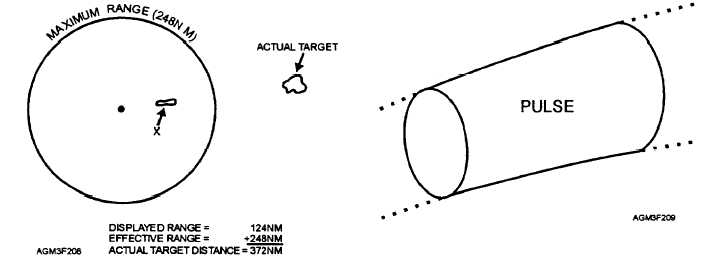Range Ambiguity
As described earlier, the pulse repetition
frequency largely determines the maximum range of
the radar set. If the period between successive pulses is
too short, an echo from a distant target may return after
the transmitter has emitted another pulse. This would
make it impossible to tell whether the observed pulse is
the echo of the pulse just transmitted or the echo of the
preceding pulse. This produces a situation referred to
as range ambiguity. The radar is unable to distinguish
between pulses, and derives range information that is
ambiguous (unreliable).
In theory, it is best to strike a target with as many
pulses of energy as possible during a given scan. Thus,
the higher the PRF the better. A high PRF improves
resolution and range accuracy by sampling the position
of the target more often. Since PRF can limit maximum
range, a compromise is reached by selectively
increasing the PRF at shorter ranges to obtain the
desired accuracy of measurements.
The maximum unambiguous range (Rmax) is the
longest range to which a transmitted pulse can travel
and return to the radar before the next pulse is
transmitted. In other words, Rmax is the maximum
distance radar energy can travel round trip between
pulses and still produce reliable information. The
relationship between the PRF and Rmax determines
the unambiguous range of the radar. The greater the
PRF (pulses per second), the shorter the maximum
unambiguous range (Rmax) of the radar. The
maximum unambiguous range of any pulse radar can
be computed with the formula: Rmax = c/(2xPRF),
where c equals the speed of light (186,000 miles per
second). Thus, the maximum unambiguous range of a
radar with a PRF of 318 would be 292 miles (254 nmi),
186,000/2 x 318 = 292. The factor of 2 in the formula
Figure 2-8.—Radar range folding.
accounts for the pulse traveling to the target and then
back to the radar.
Range Folding
While it’s true that only targets within a radar’s
normal range are detected, there are exceptions.
Occasionally, a pulse strikes a target outside of normal
range and returns during the next pulse’s listening time.
This poses a complex problem known as range folding.
Range folding may cause operators to base crucial
decisions on false echoes. The data received from this
stray pulse could be misanalyzed and echoes may be
plotted where nothing exists. The data may look
reliable and the radar may appear to be functioning
properly, adding to the deception of normal operation.
Refer to figure 2-8. Assume a pulse was emitted
during the radar’s previous scan. While it travels
beyond normal range and strikes a target, the radar
emits a second pulse. Since no targets exist within
normal radar range, these pulses will pass each other in
flight. The first pulse now returns while the radar is
expecting the second pulse (during the listening time
of the second pulse). The radar believes that the second
pulse has struck a target 124 nmi from the antenna and
displays. an echo accordingly (target "X"). The
operator is fooled by target "X" and issues a severe
weather warning, when in fact, no clouds are present.
Target "X" was an illusion, a reflection of a
thunderstorm located 372 nmi from the antenna.
Fortunately, the WSR-88D is equipped with a range
unfolding mechanism that attempts to position all
echoes properly.
Pulse Volume
As pulses travel they look like a cone with its point
cut off (fig. 2-9). They expand with the beam and
increase in volume. The volume of a pulse is the space
Figure 2-9.—Radar pulse volume. Pulse volume increases with
distance from the antenna as the pulse expands in all
directions.
2-7



